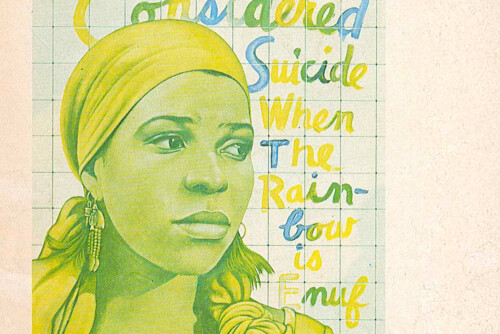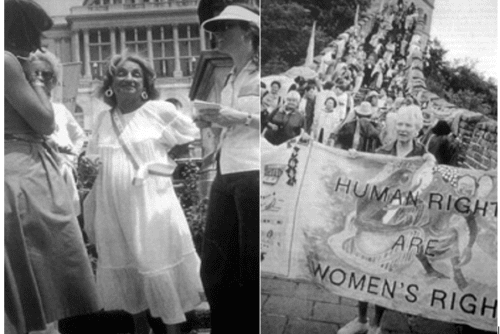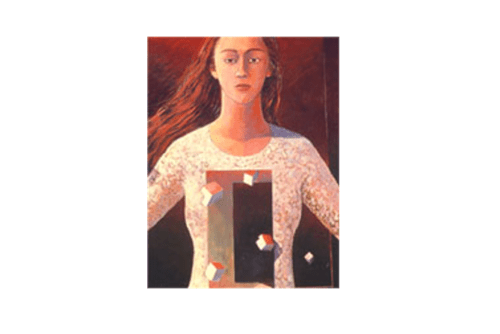iii.
Indigo Manifestations
You might be getting the sense that I find the genius represented in the character of Indigo immensely valuable for the sustaining and transforming practice of black feminism. At some point, it was not enough just to keep buying copies of the novel for people in my community (like the English teacher I am) and begging them to read it. I needed to create structures through which my diversely literate community with widely varied access to education could actually live—daily, weekly, monthly—inside of what this forum calls the Worlds of Ntozake Shange.23
Warrior Healers Organizing Trust
The Warrior Healers Organizing Trust, a local foundation in transition dedicated to organic reparations, the transformation of blood money into blood relations, and participating in the end of capitalism (which, by the way, requires us to transform, to phase out economic currency, and re-center around the primary ecological resource of love), made grants to warrior healers, those oppressed geniuses cultivating the fierce healing practice of transformation in creative ways in our community. And when we wanted to think beyond the binary of masculine and feminine, beyond the fragmenting paradigm of either unhealthy, unsustainable, round-the-clock, organizing work to fight the injustices that harm our loved ones or supposedly depoliticized, healer-mother, wise irrelevance, we turned to Indigo. A true warrior healer, ferocious in her rootedness, transformative in her presence, grounded in the traditions of women and yet un-Westernizing the meaning of gender in her stand for dignity. As we identified and supported warrior healers in our community, Indigo subjectivity pushed us to move away from the traditional grant-making process that some folks familiar to the artist/activist hustle were very familiar with and that some folks hustling in crucial ways would have found inaccessible. We ended up funding a warrior healer who found that she was too much in her head so that she could take dance classes; longtime activists at risk of losing their houses, so they would be able to pay their mortgages; a mother and grandmother who had also raised her siblings so she could hike the Appalachian trail; an executive director of a grassroots organization who put everyone else first, so she could fill her glasses’ prescription and repair her car; a genderqueer activist media maker who could stop commuting to Durham and be able to afford to move to and make roots in Durham; a youth activist to pay the gap in her college tuition; arrested activists to pay legal fees; a dancer who wanted to create a community project who needed professional advice and mentorship; a songstress in need of spiritual advice; and many other awards. In addition to these fellowships, designed through in-depth conversations about what would give the warrior healers we were interconnected with a boost, we organized a gathering where these warrior healers could meet each other and serve as continued resources for each other.
Indigo Days: 2011
In summer 2011, self-identified black warrior healers (which as you may know is not a census category) came from around the United States to gather in Durham, North Carolina, for a full week of intensive skill-sharing and prismatic community, building our work as dancers, visionary space activators, healing touch practitioners, artisans and designers, yoga teachers, womb healers, and vegan black-eyed pea stirrers for a transformative intergenerational gathering where we—warrior healers ranging from teenaged to seventy-plus-years old—got our hands blue with the practical meaning and revolutionary purpose of our practices. The New-York-City-based performance troupe Body Ecology debuted a performance of an interactive reproductive justice piece based on Indigo’s rituals. The seven-day Indigo Gathering was not the result of any grant or any outside funding whatsoever. It was one hundred percent the result of black warrior healers and allies housing each other, cooking for each other, crowdraising on Facebook for each other, and reminding ourselves and each other that we are enough, and not only when our priorities ironically, accidently, or sadly converge with the priorities of the fabulously funded foundations who are steadily trying to get us to believe that black love is not black wealth.24 Thank the goddess Ntozake Shange for Indigo, who reminds us how money moves, how dreams are real, how everything is useful, and how we have what we need because we are what we need, amen. As a result of this gathering, elder Indigo energy healers got assistance from young tech-savvy Indigos to create websites for their businesses. People connected to share mentorship that has lasted for years. Indigos facing homelessness shared housing with each other across the United States. This network of Indigos continues be a supportive resource for those of us who are sometimes marginalized or even criminalized due to the South in us. And, of course, Indigos fell in love with each other. Rub your hands together. Clap your hands together. Warrior healer energy was in your hands already. Save up and give the next warrior healer you see a high five. Alright? Alright. Indigo is here.
Indigo Night School
For two seasons on the new moon we gathered at what we call “Indigo Night School,” a space (also known as my living room) for local black warrior healers to practice collective versions of the individual healing rituals that Indigo designs for her dolls. Our elaborate full-moon-night tea rituals, where we drink phases of tea and work with the natural materials mentioned in Indigo’s remedies have been a life-saving space for those warrior healers, black women, and black genderqueer visionaries raising grandchildren, fighting for food justice, doing the daily work of antiviolence, struggling through education, and doing thankless labor all the time. At the door sits a bowl of steaming lavender water, and we wash off the day and place the names of the ancestors we bring in a bright orange bowl. We sit seriously, laughingly, lovingly; stand under a magnolia tree saying seven times the names of those who have hurt us to remove the scent of evil and release ourselves from trauma; divide bowls of berries into cold water as temporary prayer beads; read one another’s dreams into numerically syllabized poems of bite-sized wisdom, drinking consecutive teas—cinnamon, peppermint, raspberry leaf, chamomile, honey-sweetened blueberry for Indigo’s sweet presence in our lives; and we witness one another’s intentions for new moon empty-full space in the sky. This gathering space has deepened local collaborations in our community and offered black women and black genderqueer participants a deeper, more intimate way of knowing and trusting each other.
Indigo Afterschool Geniuses
Indigo knew she could travel to the moon anytime she wanted if she had the requisite plant matter and a connection to the women who came before her. In the fall after I organized a weeklong summer gathering called Indigo Days, ten-year old Alex Lockhart said to her mother (participant and novelist) Zelda Lockhart, “I want to go to an afterschool program with other girls my age at Alexis’s house.” This was my Macarthur Genius Not-Taken-For-Granted Award, the sweetest validation that I was doing it right, that the young black genius girls in my community would claim this queer relationship to black feminist books I have as place for them to live, a place for them to be themselves, after school or anytime. It really should be the first line of my bio, my greatest achievement so far: Sista Docta Alexis Pauline Gumbs is available to Durham’s Indigos.
So, of course, I turned to Indigo. Like Indigo, the sixth-grade girls who gathered—just starting middle school, sometimes literally getting their periods for the first time at my house surrounded by Indigo invocations and tea—were all the youngest sisters. We made dolls, we made a Pandora instrumental station for the meditative writing that they wanted to do every week. We checked in about how we were doing and blew bubbles to release any negative energy—pop. We drank a special organic tea called “Indigo is the Folks” designed especially for these girls by fourth-generation black feminist herbalist and interdisciplinary artist Alexis Pierre-Louis. We ate decadent afterschool meals prepared by grown participants in the Eternal Summer of the Black Feminist Mind educational program, who exemplified the belief that what and whether and how a black girl eats after school is a community concern that goes far beyond individual mothers. During that sixth-grade year the Indigos provided rigorous cheering sections for one another’s musical and dance recitals, created a not-so-secret hideout in my backyard that they told everyone about; hosted an intergenerational Marvelous Menstruating Moments ritual gathering for period-age black kids and their mommas and aunties that my mother and I co-facilitated; and created a museum of sisterhood where they taught dozens of people in our community about their 11 commandments of sisterhood and mentored people much older than they were in the challenging practice of sistering in community. In the seventh grade, the Indigo Geniuses embarked on an outgrowth called Indigo Journeys, a series of Saturday fieldtrips to important black feminist sites in North Carolina (like Pauli Murray’s house, Charlotte Hawkins Brown’s school, Ella Baker and Anna Julia Cooper’s alma maters, as well as regular local sites of their own breakthroughs … where they learned to ride bikes, where they stood up for themselves) and creating temporary installation monuments to their spatial practice of brilliance. They demonstrated in the twice-a-week afterschool sessions and the sisterhood museum, where you had to sing an affirming song to get in the door, that they knew how to create sacred space. They embarked on Indigo Journeys in order to deepen their practice of moving through the world as ancestrally connected sacred portal monument sites.25 Black seventh-grade girls moving in their power. The South in us. Now, as eighth graders very close to moving on to high school, they are focusing on their embodied power. In response to street harassment and affronts from grabby boys (one of whom declared a school-wide butt-grabbing day at one of their schools) we have created weekly dance sessions inspired by the dance experiences of Indigo’s older sister Cypress. These dance sessions are not for performance but rather for embodied listening, a safe space to explore how bodies feel in movement with the ideas that are important to them.
On soccer and track teams, in dance companies and art classes, and all day at three different middle schools in Durham they continue Indigo’s practice of creating and sharing the rituals they need. Here are three of the remedies they came up with on the very first day of Indigo Afterschool in 2011, which we are now offering as a gift when you donate toward the transportation and art supply costs for the Indigo Journeys program. Here are some remedies inspired by Emergency Care for Wounds that Cannot Be Seen:
Emergency Care for the “the funk”:
by Bailey Jo Wadlington(like on Glee, when they were in a funk because they were afraid their singing group wasn’t good enough)
Surround oneself with loved ones, then go on top of a tall object and scream to hearts content all of ones deepest feelings. If this does not work, go in private room and listen to songs that mention only of happy things, then write down all of one’s problems and think of a way to turn them around.
Emergency for Sadness:
by Assata Carter-Goff1. go to the bathroom and turn on hot water. let it steam.
2. get your favorite incense and burn it
3. get a robe and put it on
4. put the incense in the bathroom
5. put a stool in the bathroom
6. write all the things you are sad about on a piece of paper
7. write on the steamed mirror all the things that are peaceful
8. sit in the bathroom and be peaceful with the steaming and the incenseForged by Fire (for hard experiences that change you forever):
by Alex LockhartBathe in a tub of warm water without bubbles. Slowly lie down and let all the bad energy out. When you get out, don’t dry off, instead go to a silent room and let the peaceful air dry you off. Next rub your skin with soothing lavender oil. Now go outside and let the sun wrap its loving rays around you.
These are our Indigos. Witness your own Indigo subjectivity. The South in us. To paraphrase Ntozake Shange, they “serve notice that the colored children are manifestations of the 21st century” and every century before.26 How can you doubt that we can go to the moon, stay here and evolve into alignment with the planet, or do anything else we might collectively need to do?
I never knew that it was possible for such a variety of black folks with different ages and genders and spiritual practices to join me so faithfully and sincerely in practicing the invented rituals of an invented black adolescent. I hope you immerse yourself and bring it into your life beyond the plasma plastic of your computer screen.
As you sit reading, bear witness. Take five quick breaths. And three slow ones. Yes. Yes. We are on our way.
Bibliography (for researchers and educators)
Source Texts:
- M. Jacqui Alexander, Pedagogies of Crossing: Meditations on Feminism, Sexual Politics, Memory and the Sacred (Durham: Duke UP, 2005).
- Lisa Factora-Borchers, Dear Sister: Letters from Survivors of Sexual Violence (Oakland: AK Press, 2014).
- Akasha Gloria Hull, Soul Talk: The New Spirituality of African American Women (Rochester, Inner Traditions, 2001).
- Alondra Nelson, Body and Soul: The Black Panther Party and the Fight Against Medical Discrimination (Minneapolis: U of Minnesota P, 2013).
- Loretta Ross, “The Color of Choice: White Supremacy and Reproductive Justice” The Color of Violence: The Incite Anthology (Boston: South End, 2006) 53-65.
- Ntozake Shange, Sassafrass, Cypress and Indigo (New York: St. Martin’s, 1982).
- Ntozake Shange, Sassafrass (Berkeley: Shameless Hussy, 1976).
More information on the work:
- Alexis Pauline Gumbs, “Home: A Small Brown Place,” The Scholar & Feminist Online 3.2 (2005).
- Alexis Pauline Gumbs, “this is what it sounds like (an ecological approach),” The Scholar & Feminist Online 8.3 (2010).
Indigo Days: A Gathering of Black Warrior Healers:
Indigo Afterschool Program:
Other Resources:
- In addition to the initiatives described here, other work in our community inspired by Ntozake Shange’s work includes the Sassafrass Survival Salon, addressing relationship violence in our community, and the Rainbow Reclamations Ritual series for women of color based on for colored girls. Ntozake Shange—your work is food and medicine in my community. [↩]
- Nikki Giovanni, “Black love is black wealth,” Black Feeling Black Talk (New York: Harper Collins, 1968). [↩]
- Recently the Indigo Journey’s program was honored with a gift from the We Shall Overcome fund at the Highlander Center. They are also playing a priceless role in the transformation of Pauli Murray’s childhood home into the Pauli Murray Center for Social Justice in Durham. [↩]
- Shange, Sassafrass 1982: 40. [↩]



